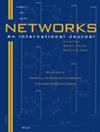The hazardous orienteering problem
IF 1.3
4区 计算机科学
Q4 COMPUTER SCIENCE, HARDWARE & ARCHITECTURE
引用次数: 0
Abstract
This article studies the Hazardous Orienteering Problem (HOP), a variant of the more famous Orienteering Problem (OP). In the OP, a vehicle earns a profit for each customer it visits (e.g., to pick up a parcel) subject to an upper bound on the tour time. In the HOP, the parcels picked up at some customers have a probability of triggering a catastrophic event. The probability depends on how long the parcels travel on the vehicle. If any catastrophic event triggers, the entire collected profit is lost. The goal is to determine the tour that maximizes the expected profit. The problem has interesting applications in routing of hazardous material, cash‐in‐transit, and law enforcement. We propose a mixed‐integer nonlinear formulation and techniques both to obtain dual bounds and to produce primal solutions. Computational tests investigate the efficacy of the methods proposed and allow to gain insights into solution features.危险的定向运动问题
本文研究了危险定向问题(HOP),这是更著名的定向问题(OP)的一个变体。在OP中,车辆在行驶时间有上限的情况下,每拜访一个客户(例如,取一个包裹)就能获得利润。在HOP中,某些客户收到的包裹有可能引发灾难性事件。概率取决于包裹在运输工具上行驶的时间。如果发生任何灾难性事件,则所有收集的利润都将损失。目标是确定使预期利润最大化的路线。这个问题在危险物质的运输路线、现金运输和执法方面有有趣的应用。我们提出了一个混合整数非线性公式和技术,以获得对偶边界和产生原解。计算测试研究了所提出的方法的有效性,并允许深入了解解决方案的特征。
本文章由计算机程序翻译,如有差异,请以英文原文为准。
求助全文
约1分钟内获得全文
求助全文
来源期刊

Networks
工程技术-计算机:硬件
CiteScore
4.40
自引率
9.50%
发文量
46
审稿时长
12 months
期刊介绍:
Network problems are pervasive in our modern technological society, as witnessed by our reliance on physical networks that provide power, communication, and transportation. As well, a number of processes can be modeled using logical networks, as in the scheduling of interdependent tasks, the dating of archaeological artifacts, or the compilation of subroutines comprising a large computer program. Networks provide a common framework for posing and studying problems that often have wider applicability than their originating context.
The goal of this journal is to provide a central forum for the distribution of timely information about network problems, their design and mathematical analysis, as well as efficient algorithms for carrying out optimization on networks. The nonstandard modeling of diverse processes using networks and network concepts is also of interest. Consequently, the disciplines that are useful in studying networks are varied, including applied mathematics, operations research, computer science, discrete mathematics, and economics.
Networks publishes material on the analytic modeling of problems using networks, the mathematical analysis of network problems, the design of computationally efficient network algorithms, and innovative case studies of successful network applications. We do not typically publish works that fall in the realm of pure graph theory (without significant algorithmic and modeling contributions) or papers that deal with engineering aspects of network design. Since the audience for this journal is then necessarily broad, articles that impact multiple application areas or that creatively use new or existing methodologies are especially appropriate. We seek to publish original, well-written research papers that make a substantive contribution to the knowledge base. In addition, tutorial and survey articles are welcomed. All manuscripts are carefully refereed.
 求助内容:
求助内容: 应助结果提醒方式:
应助结果提醒方式:


